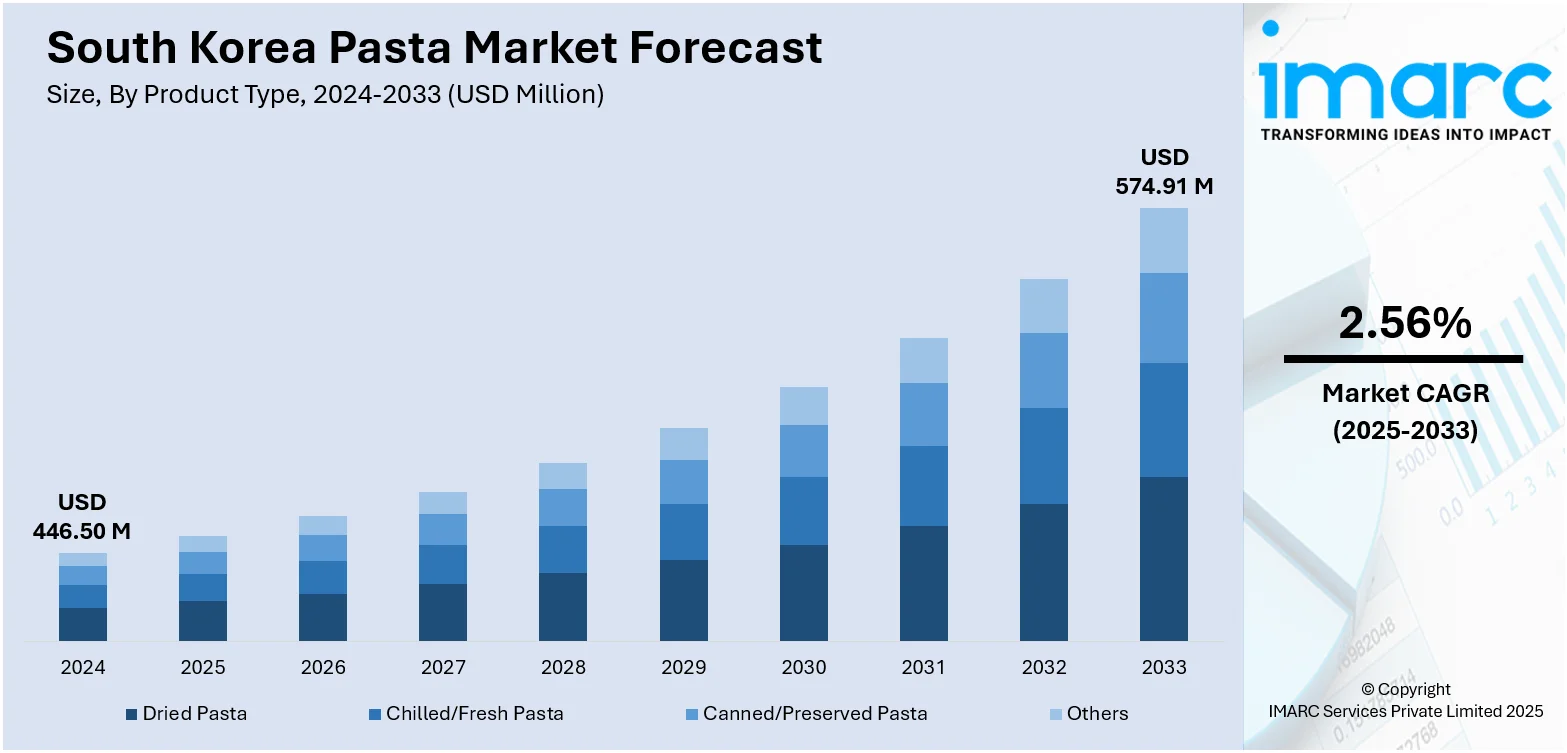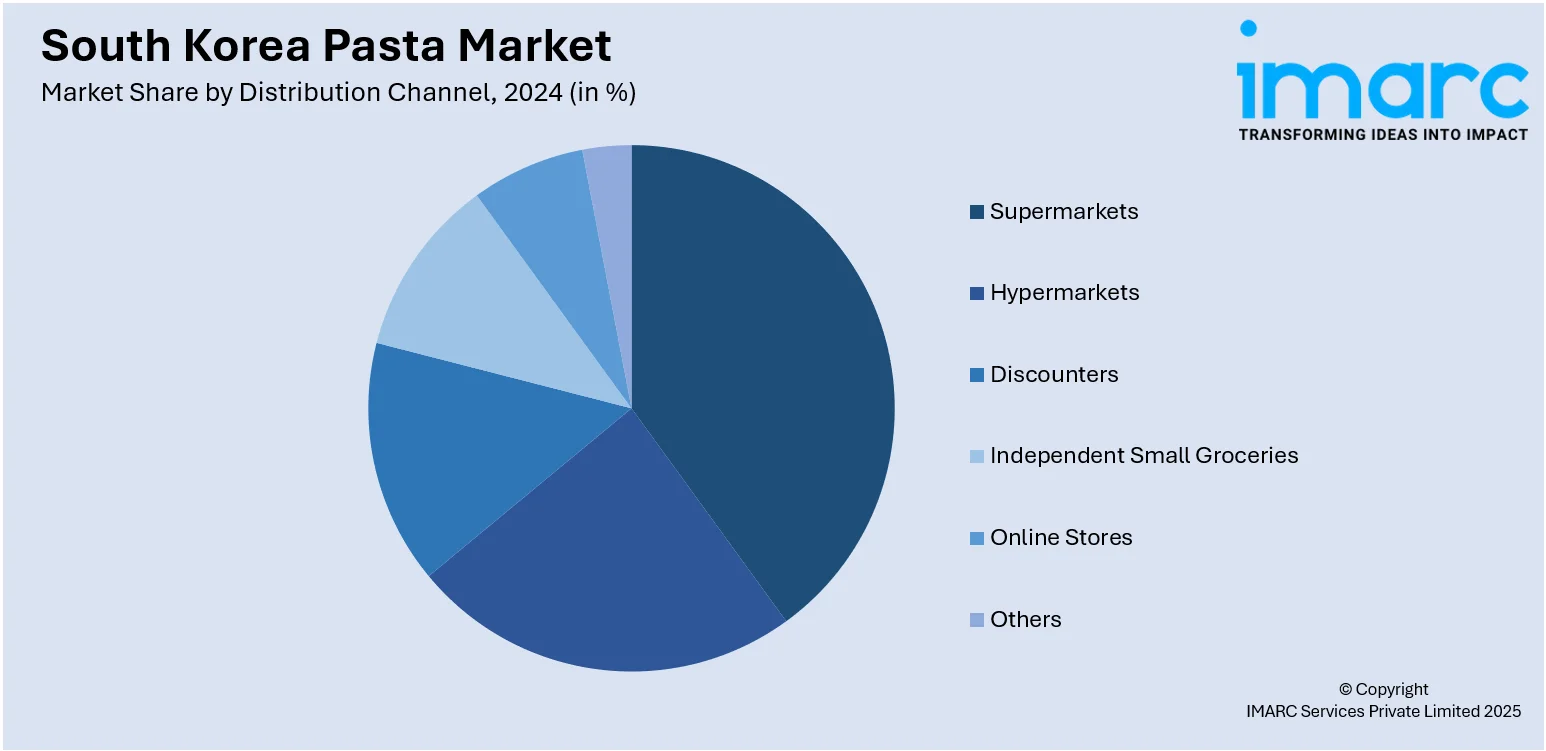
South Korea Pasta Market Size, Share, Trends and Forecast by Product Type, Raw Material, Distribution Channel, and Region, 2025-2033
South Korea Pasta Market Overview:
The South Korea pasta market size reached USD 446.50 Million in 2024. Looking forward, the market is expected to reach USD 574.91 Million by 2033, exhibiting a growth rate (CAGR) of 2.56% during 2025-2033. Increasing consumer interest in convenient and international cuisine, expanding retail availability of premium and ready-to-cook pasta, and rising disposable incomes are fueling demand. Growing health awareness spurs sauces and pasta with whole grain or gluten-free options, thereby boosting South Korea pasta market share.
|
Report Attribute
|
Key Statistics
|
|---|---|
|
Base Year
|
2024
|
|
Forecast Years
|
2025-2033
|
|
Historical Years
|
2019-2024
|
| Market Size in 2024 | USD 446.50 Million |
| Market Forecast in 2033 | USD 574.91 Million |
| Market Growth Rate 2025-2033 | 2.56% |
South Korea Pasta Market Trends:
Premium and Health‑Oriented Offerings
The South Korea pasta market growth is being propelled by manufacturers introducing premium, health-focused products such as whole-grain and gluten-free pasta. Consumers increasingly demand nutritious alternatives, seeking high-fiber, low-carb, or plant-based options. Producers are responding by offering fortified pasta with added protein, vitamins, and minerals. This aligns with broader global trends of functional foods, where taste is only one of many considerations. Premium sauces—with natural, organic ingredients—also complement these healthier pasta lines. With rising awareness of diet-related health issues, this segment is expected to expand further, capturing interest from both health-conscious individuals and families looking for balanced meal options. For instance, in March 2024, Barilla expanded its Protein+® pasta line with the introduction of Cellentani, a corkscrew-shaped pasta made from chickpeas, lentils, and peas, offering 17g of protein and 10g of fiber per serving.

To get more information on this market, Request Sample
Premiumization of Sauces and Ready Meals
A key trend supporting South Korea pasta market growth is the premiumization of complementary products like sauces, ready-to-eat pasta meals, and meal kits. Consumers expect gourmet-quality sauces, including artisanal pesto, truffle-infused cream, and authentic Italian tomato blends. Companies are launching complete meal kits featuring pasta and freshly prepared sauces—often refrigerated—to cater to busy urban professionals. Collaboration with celebrity chefs and influencers enhances product appeal through endorsements and limited-edition recipes. These upscale offerings position pasta as a convenient yet refined dining choice, shifting consumer perception from basic carbs to a cuisine-driven, elevated experience, which in turn drives market expansion. For instance, in August 2024, Toowoomba Pasta, a seafood pasta dish introduced by Outback Steakhouse, became a popular convenience meal in South Korea. Named after an Australian city, it is widely available in convenience stores and restaurants. Experts highlight this success as an opportunity for Australian businesses to showcase authentic products in Korea, a growing market for premium goods.
South Korea Pasta Market Segmentation:
IMARC Group provides an analysis of the key trends in each segment of the market, along with forecasts at the country and regional levels for 2025-2033. Our report has categorized the market based on product type, raw material, and distribution channel.
Product Type Insights:
- Dried Pasta
- Chilled/Fresh Pasta
- Canned/Preserved Pasta
- Others
The report has provided a detailed breakup and analysis of the market based on the product type. This includes dried pasta, chilled/fresh pasta, canned/preserved pasta, and others.
Raw Material Insights:
- Durum Wheat Semolina
- Wheat
- Mix
- Barley
- Rice
- Maize
- Others
A detailed breakup and analysis of the market based on the raw material have also been provided in the report. This includes durum wheat semolina, wheat, mix, barley, rice, maize, and others.
Distribution Channel Insights:

- Supermarkets
- Hypermarkets
- Discounters
- Independent Small Groceries
- Online Stores
- Others
The report has provided a detailed breakup and analysis of the market based on the distribution channel. This includes supermarkets, hypermarkets, discounters, independent small groceries, online stores, and others.
Regional Insights:
- Seoul Capital Area
- Yeongnam (Southeastern Region)
- Honam (Southwestern Region)
- Hoseo (Central Region)
- Others
The report has also provided a comprehensive analysis of all the major regional markets, which include Seoul Capital Area, Yeongnam (Southeastern Region), Honam (Southwestern Region), Hoseo (Central Region), and others.
Competitive Landscape:
The market research report has also provided a comprehensive analysis of the competitive landscape. Competitive analysis such as market structure, key player positioning, top winning strategies, competitive dashboard, and company evaluation quadrant has been covered in the report. Also, detailed profiles of all major companies have been provided.
South Korea Pasta Market News:
- In April 2025, Barilla became the official pasta partner of Formula 1 through a multi-year collaboration. The partnership emphasizes shared values of quality, passion, and tradition. Barilla will feature in F1 events with pasta bars in the Paddock Club, trackside branding, and global promotions, bringing fans together through food and racing.
South Korea Pasta Market Report Coverage:
| Report Features | Details |
|---|---|
| Base Year of the Analysis | 2024 |
| Historical Period | 2019-2024 |
| Forecast Period | 2025-2033 |
| Units | Million USD |
| Scope of the Report |
Exploration of Historical Trends and Market Outlook, Industry Catalysts and Challenges, Segment-Wise Historical and Future Market Assessment:
|
| Product Types Covered | Dried Pasta, Chilled/Fresh Pasta, Canned/Preserved Pasta, Others |
| Raw Materials Covered | Durum Wheat Semolina, Wheat, Mix, Barley, Rice, Maize, Others |
| Distribution Channels Covered | Supermarkets, Hypermarkets, Discounters, Independent Small Groceries, Online Stores, Others |
| Regions Covered | Seoul Capital Area, Yeongnam (Southeastern Region), Honam (Southwestern Region), Hoseo (Central Region), Others |
| Customization Scope | 10% Free Customization |
| Post-Sale Analyst Support | 10-12 Weeks |
| Delivery Format | PDF and Excel through Email (We can also provide the editable version of the report in PPT/Word format on special request) |
Key Questions Answered in This Report:
- How has the South Korea pasta market performed so far and how will it perform in the coming years?
- What is the breakup of the South Korea pasta market on the basis of product type?
- What is the breakup of the South Korea pasta market on the basis of raw material?
- What is the breakup of the South Korea pasta market on the basis of distribution channel?
- What is the breakup of the South Korea pasta market on the basis of region?
- What are the various stages in the value chain of the South Korea pasta market?
- What are the key driving factors and challenges in the South Korea pasta market?
- What is the structure of the South Korea pasta market and who are the key players?
- What is the degree of competition in the South Korea pasta market?
Key Benefits for Stakeholders:
- IMARC’s industry report offers a comprehensive quantitative analysis of various market segments, historical and current market trends, market forecasts, and dynamics of the South Korea pasta market from 2019-2033.
- The research report provides the latest information on the market drivers, challenges, and opportunities in the South Korea pasta market.
- Porter's five forces analysis assist stakeholders in assessing the impact of new entrants, competitive rivalry, supplier power, buyer power, and the threat of substitution. It helps stakeholders to analyze the level of competition within the South Korea pasta industry and its attractiveness.
- Competitive landscape allows stakeholders to understand their competitive environment and provides an insight into the current positions of key players in the market.
Need more help?
- Speak to our experienced analysts for insights on the current market scenarios.
- Include additional segments and countries to customize the report as per your requirement.
- Gain an unparalleled competitive advantage in your domain by understanding how to utilize the report and positively impacting your operations and revenue.
- For further assistance, please connect with our analysts.
 Request Customization
Request Customization
 Speak to an Analyst
Speak to an Analyst
 Request Brochure
Request Brochure
 Inquire Before Buying
Inquire Before Buying




.webp)




.webp)












